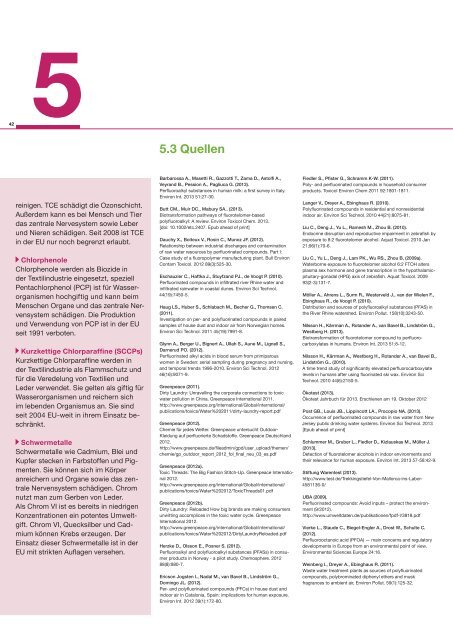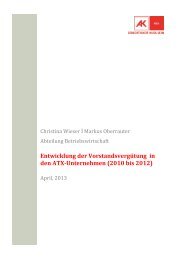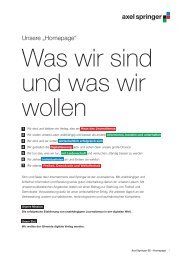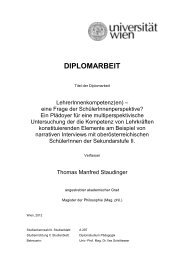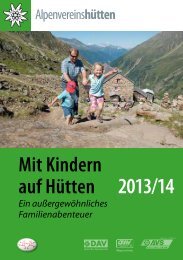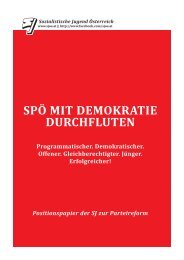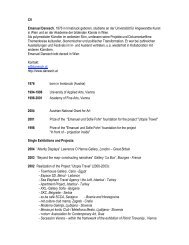Greenpeace Report "Chemie für Gipfelstürmer" - derStandard.at
Greenpeace Report "Chemie für Gipfelstürmer" - derStandard.at
Greenpeace Report "Chemie für Gipfelstürmer" - derStandard.at
Sie wollen auch ein ePaper? Erhöhen Sie die Reichweite Ihrer Titel.
YUMPU macht aus Druck-PDFs automatisch weboptimierte ePaper, die Google liebt.
42<br />
5<br />
5.3 Quellen<br />
reinigen. TCE schädigt die Ozonschicht.<br />
Außerdem kann es bei Mensch und Tier<br />
das zentrale Nervesystem sowie Leber<br />
und Nieren schä digen. Seit 2008 ist TCE<br />
in der EU nur noch begrenzt erlaubt.<br />
Chlorphenole<br />
Chlorphenole werden als Biozide in<br />
der Textilindustrie eingesetzt, speziell<br />
Pentachlorphenol (PCP) ist <strong>für</strong> Wasserorganismen<br />
hochgiftig und kann beim<br />
Menschen Organe und das zentrale Nervensystem<br />
schädigen. Die Produk tion<br />
und Verwendung von PCP ist in der EU<br />
seit 1991 verboten.<br />
Kurzkettige Chlorparaffine (SCCPs)<br />
Kurzkettige Chlorparaffine werden in<br />
der Textilindustrie als Flammschutz und<br />
<strong>für</strong> die Veredelung von Textilien und<br />
Leder verwendet. Sie gelten als giftig <strong>für</strong><br />
Wasserorganismen und reichern sich<br />
im lebenden Organismus an. Sie sind<br />
seit 2004 EU-weit in ihrem Eins<strong>at</strong>z beschränkt.<br />
Schwermetalle<br />
Schwermetalle wie Cadmium, Blei und<br />
Kupfer stecken in Farbstoffen und Pigmenten.<br />
Sie können sich im Körper<br />
anreichern und Organe sowie das zentrale<br />
Nervensystem schädigen. Chrom<br />
nutzt man zum Gerben von Leder.<br />
Als Chrom VI ist es bereits in niedrigen<br />
Konzentr<strong>at</strong>ionen ein potentes Umweltgift.<br />
Chrom VI, Quecksilber und Cadmium<br />
können Krebs erzeugen. Der<br />
Eins<strong>at</strong>z dieser Schwermetalle ist in der<br />
EU mit strikten Auflagen versehen.<br />
Barbarossa A., Masetti R., Gazzotti T., Zama D., Astolfi A.,<br />
Veyrand B., Pession A., Pagliuca G. (2013).<br />
Perfluoroalkyl substances in human milk: a first survey in Italy.<br />
Environ Int. 2013 51:27-30.<br />
Butt CM., Muir DC., Mabury SA.. (2013).<br />
Biotransform<strong>at</strong>ion p<strong>at</strong>hways of fluorotelomer-based<br />
polyfluoroalkyl: A review. Environ Toxicol Chem. 2013.<br />
[doi: 10.1002/etc.2407. Epub ahead of print]<br />
Dauchy X., Boiteux V., Rosin C., Munoz JF. (2012).<br />
Rel<strong>at</strong>ionship between industrial discharges and contamin<strong>at</strong>ion<br />
of raw w<strong>at</strong>er resources by perfluorin<strong>at</strong>ed compounds. Part I:<br />
Case study of a fluoropolymer manufacturing plant. Bull Environ<br />
Contam Toxicol. 2012 89(3):525-30.<br />
Eschauzier C., Haftka J., Stuyfzand PJ., de Voogt P. (2010).<br />
Perfluorin<strong>at</strong>ed compounds in infiltr<strong>at</strong>ed river Rhine w<strong>at</strong>er and<br />
infiltr<strong>at</strong>ed rainw<strong>at</strong>er in coastal dunes. Environ Sci Technol.<br />
44(19):7450-5.<br />
Haug LS., Huber S., Schlabach M., Becher G., Thomsen C.<br />
(2011).<br />
Investig<strong>at</strong>ion on per- and polyfluorin<strong>at</strong>ed compounds in paired<br />
samples of house dust and indoor air from Norwegian homes.<br />
Environ Sci Technol. 2011 45(19):7991-8.<br />
Glynn A., Berger U., Bignert A., Ullah S., Aune M., Lignell S.,<br />
Darnerud PO. (2012).<br />
Perfluorin<strong>at</strong>ed alkyl acids in blood serum from primiparous<br />
women in Sweden: serial sampling during pregnancy and nursing,<br />
and temporal trends 1996-2010. Environ Sci Technol. 2012<br />
46(16):9071-9.<br />
<strong>Greenpeace</strong> (2011).<br />
Dirty Laundry: Unravelling the corpor<strong>at</strong>e connections to toxic<br />
w<strong>at</strong>er pollution in China. <strong>Greenpeace</strong> Intern<strong>at</strong>ional 2011.<br />
http://www.greenpeace.org/intern<strong>at</strong>ional/Global/intern<strong>at</strong>ional/<br />
public<strong>at</strong>ions/toxics/W<strong>at</strong>er%202011/dirty-laundry-report.pdf<br />
<strong>Greenpeace</strong> (2012).<br />
<strong>Chemie</strong> <strong>für</strong> jedes Wetter. <strong>Greenpeace</strong> untersucht Outdoor-<br />
Kleidung auf perfluorierte Schadstoffe. <strong>Greenpeace</strong> Deutschland<br />
2012.<br />
http://www.greenpeace.de/fileadmin/gpd/user_upload/themen/<br />
chemie/gp_outdoor_report_2012_fol_final_neu_03_es.pdf<br />
<strong>Greenpeace</strong> (2012a).<br />
Toxic Threads: The Big Fashion Stitch-Up. <strong>Greenpeace</strong> Intern<strong>at</strong>ional<br />
2012.<br />
http://www.greenpeace.org/intern<strong>at</strong>ional/Global/intern<strong>at</strong>ional/<br />
public<strong>at</strong>ions/toxics/W<strong>at</strong>er%202012/ToxicThreads01.pdf<br />
<strong>Greenpeace</strong> (2012b).<br />
Dirty Laundry: Reloaded How big brands are making consumers<br />
unwitting accomplices in the toxic w<strong>at</strong>er cycle. <strong>Greenpeace</strong><br />
Intern<strong>at</strong>ional 2012.<br />
http://www.greenpeace.org/intern<strong>at</strong>ional/Global/intern<strong>at</strong>ional/<br />
public<strong>at</strong>ions/toxics/W<strong>at</strong>er%202012/DirtyLaundryReloaded.pdf<br />
Herzke D., Olsson E., Posner S. (2012).<br />
Perfluoroalkyl and polyfluoroalkyl substances (PFASs) in consumer<br />
products in Norway - a pilot study. Chemosphere. 2012<br />
88(8):980-7.<br />
Ericson Jogsten I., Nadal M., van Bavel B., Lindström G.,<br />
Domingo JL. (2012).<br />
Per- and polyfluorin<strong>at</strong>ed compounds (PFCs) in house dust and<br />
indoor air in C<strong>at</strong>alonia, Spain: implic<strong>at</strong>ions for human exposure.<br />
Environ Int. 2012 39(1):172-80.<br />
Fiedler S., Pfister G., Schramm K-W. (2011).<br />
Poly- and perfluorin<strong>at</strong>ed compounds in household consumer<br />
products. Toxicol Environ Chem 2011 92:1801-1811.<br />
Langer V., Dreyer A., Ebinghaus R. (2010).<br />
Polyfluorin<strong>at</strong>ed compounds in residential and nonresidential<br />
indoor air. Environ Sci Technol. 2010 44(21):8075-81.<br />
Liu C., Deng J., Yu L., Ramesh M., Zhou B. (2010).<br />
Endocrine disruption and reproductive impairment in zebrafish by<br />
exposure to 8:2 fluorotelomer alcohol. Aqu<strong>at</strong> Toxicol. 2010 Jan<br />
21;96(1):70-6.<br />
Liu C., Yu L., Deng J., Lam PK., Wu RS., Zhou B. (2009a).<br />
W<strong>at</strong>erborne exposure to fluorotelomer alcohol 6:2 FTOH alters<br />
plasma sex hormone and gene transcription in the hypothalamicpituitary-gonadal<br />
(HPG) axis of zebrafish. Aqu<strong>at</strong> Toxicol. 2009<br />
93(2-3):131-7.<br />
Möller A., Ahrens L., Surm R., Westerveld J., van der Wielen F.,<br />
Ebinghaus R., de Voogt P. (2010).<br />
Distribution and sources of polyfluoroalkyl substances (PFAS) in<br />
the River Rhine w<strong>at</strong>ershed. Environ Pollut. 158(10):3243-50.<br />
Nilsson H., Kärrman A., Rotander A., van Bavel B., Lindström G.,<br />
Westberg H. (2013).<br />
Biotransform<strong>at</strong>ion of fluorotelomer compound to perfluorocarboxyl<strong>at</strong>es<br />
in humans. Environ Int. 2013 51:8-12.<br />
Nilsson H., Kärrman A., Westberg H., Rotander A., van Bavel B.,<br />
Lindström G.. (2010).<br />
A time trend study of significantly elev<strong>at</strong>ed perfluorocarboxyl<strong>at</strong>e<br />
levels in humans after using fluorin<strong>at</strong>ed ski wax. Environ Sci<br />
Technol. 2010 44(6):2150-5.<br />
Ökotest (2013).<br />
Ökotest Jahrbuch <strong>für</strong> 2013. Erschienen am 19. Oktober 2012<br />
Post GB., Louis JB., Lippincott LA., Procopio NA. (2013).<br />
Occurrence of perfluorin<strong>at</strong>ed compounds in raw w<strong>at</strong>er from New<br />
Jersey public drinking w<strong>at</strong>er systems. Environ Sci Technol. 2013<br />
[Epub ahead of print]<br />
Schlummer M., Gruber L., Fiedler D., Kizlauskas M., Müller J.<br />
(2013).<br />
Detection of fluorotelomer alcohols in indoor environments and<br />
their relevance for human exposure. Environ Int. 2013 57-58:42-9.<br />
Stiftung Warentest (2013).<br />
http://www.test.de/Trekkingstiefel-Von-Mallorca-ins-Labor-<br />
4581136-0/<br />
UBA (2009).<br />
Perfluorin<strong>at</strong>ed compounds: Avoid inputs – protect the environment<br />
(9/2012).<br />
http://www.umweltd<strong>at</strong>en.de/publik<strong>at</strong>ionen/fpdf-l/3818.pdf<br />
Vierke L., Staude C., Biegel-Engler A., Drost W., Schulte C.<br />
(2012).<br />
Perfluorooctanoic acid (PFOA) — main concerns and regul<strong>at</strong>ory<br />
developments in Europe from an environmental point of view.<br />
Environmental Sciences Europe 24:16.<br />
Weinberg I., Dreyer A., Ebinghaus R. (2011).<br />
Waste w<strong>at</strong>er tre<strong>at</strong>ment plants as sources of polyfluorin<strong>at</strong>ed<br />
compounds, polybromin<strong>at</strong>ed diphenyl ethers and musk<br />
fragrances to ambient air, Environ Pollut. 59(1):125-32.


